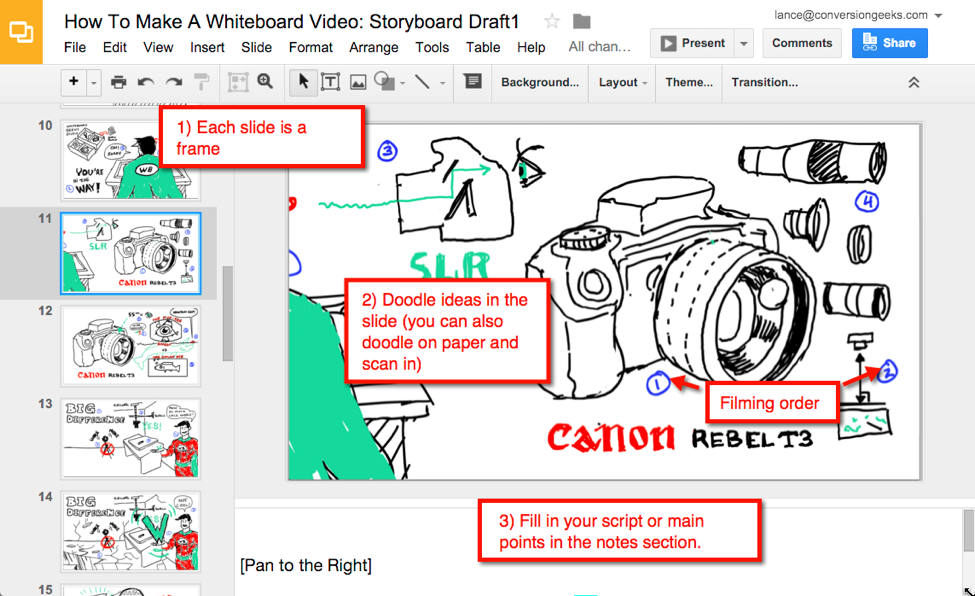Source: Vidyard We’ve all been there before. You’ve got a great idea. This lead gen video is going to be the next Dropbox success story. You talk to
We’ve all been there before.
You’ve got a great idea. This lead gen video is going to be the next Dropbox success story.
You talk to your video team. You write the script. Everyone is excited. You shoot the video. World-domination, an IPO and/or a promotion are mere frames away. You launch the video. That upload click has never felt so good.
…
Then the crickets start. And when you watch the video you realize… “this is nothing like what I had in mind!!”
What gives?
Shoulda made a storyboard.
Some people think a storyboard has got to be a Pixar-level work of art in and of itself. Or that you’ve got to be able to draw or be creative to make a good storyboard. That couldn’t be further from the truth.
Here’s a simple process we use to make storyboards so there’s less of a chance of botching production.
It’s Got To Start As An Outline
Storyboards (unfortunately) aren’t magic. If you don’t know what you’re going to say, there’s no saving it.
There are a few common outlines you can use to get started. Here are two every video marketer should have in their tool belt:
1. Hero’s Journey
Stories from Star Wars to Dropbox’s legendary explainer have harnessed this framework to make high-growth videos.
It goes like this:
- Meet the Hero, Bob.
- Bob has got a problem.
- He tried this, that, and the other thing and they didn’t work.
- Then he found the solution which works like this __________.
- Bob got this sweet, positively emotional pay-off + call to action.
2. Problem, Agitate, Solve
Cheesy infomercials have made BILLIONS with this framework.
The idea is when there’s a pressing problem you don’t want to let up on the pain, but keep pressing forward so it’s clear how much they need your solution.
Here’s a breakdown:
- Do you have this problem?
- Here are the things making your problem worse.
- This solution focuses explicitly on your big problem.
- Customer testimonials or proof.
- Benefit recap and call to action.
My software of choice is Google Presentation. One because it’s free, but two because it’s familiar and has almost zero roadblocks to getting started.
If you’ve got some paper, a cell phone camera/scanner and a Google account you’re ready to go.

Here’s a helpful, free slide template you can use. Or if you like to do the pencil-to-paper method, here are a few printable word docs.
If you’re looking to get a bit more fancy you can take a look at StoryboardThat.
Highlight Your Critical Frames
Inside a two minute video you may not have a ton of scenes, but there will always be a few critical frames.
Every marketing storyboard should have frames for:
- Opener
- Problem Statement
- How the Solution works ← Often the most critical to storyboard.
- Call to action ← This is a close second in terms of storyboard need.
Frame 1 – The Opener
The main goal in the first frame is to create a sense of mystery. If you’re working on a lead gen video, this is doubly important since a visitor is normally trading their contact info to scratch the itch of their curiosity.
Frame 2 – Problem Statement
This is the frame that should get your viewer’s head nodding (or qualify out the ones who shouldn’t be watching anyway). If you have any dark or depressing frames, this is where they’ll go.
Frame 3 – How Your Solution Works
My favorite frame of all. This is where your marketing chops come into play. You can shave major time off an explanation with a well-thought-out solution frame. Binge watch the explanation section of some late night infomercials to see this one done exceptionally well.
Frame 4 – Call To Action
Without this you might as well go home. This is a nitty gritty frame, with the most important factor being clarity. Is your URL…

COMMENTS